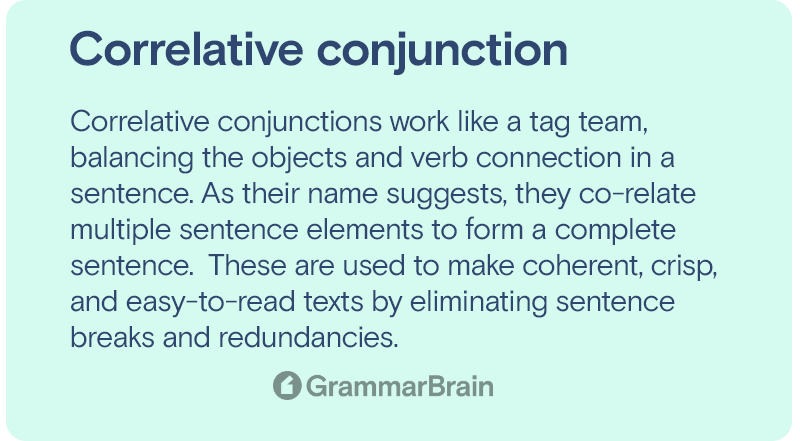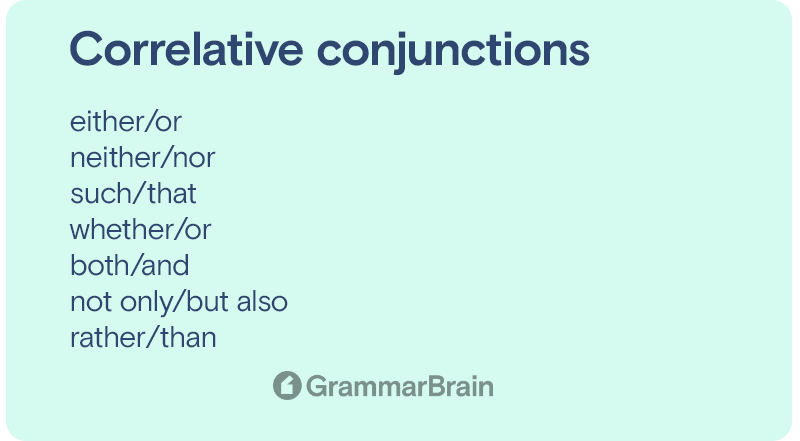What are correlative conjunctions? How does a correlative conjunction work? Writing in the English language is as much art as it is a technical skill. There are several grammatical tools that can help you beautify your linguistic works in English to make them more palatable and engrossing for the readers.
Conjunctions are just one aspect of it. Used to connect words, clauses, and broader concepts, conjunctions help you to form complex yet elegant sentences. Correlative conjunctions are used to make the flow of writing smoother and make complex concepts simpler to understand.

What are correlative conjunctions?
Correlative conjunctions are pairs of words used at different spots in a sentence to coherently connect two parts of a sentence. These conjunctions help retain the equal importance of the clauses they connect in the sentence framework.
These are essentially used to connect two singular subjects with a singular verb, or two plural subjects with a plural verb.

How are correlative conjunctions different from the other two types of conjunctions?
Correlative conjunctions, like all other types of conjunctions, link words or phrases together. However, they differ from the other types of conjunctions in two ways:
- Correlative conjunctions always exist in pairs.
- Correlative conjunctions are used to correlate or join two parts of a sentence having equal importance. They are commonly used to link two singular subjects with a singular verb, or two plural subjects with plural verbs.
Correlative conjunction vs. other conjunctions
There are two more types of conjunctions used in English grammar: Coordinating Conjunctions and Subordinating Conjunctions.
While a coordinating conjunction is used to join two elements of equal grammatical rank, subordinating conjunctions are used to connect a dependent clause to an independent clause.
Therefore, by definition and use, correlative conjunctions are similar to coordinating conjunctions as both pair equally relevant grammatical pieces of a sentence.
The only difference is that coordinating conjunction is a singular word while correlative conjunctions come in pairs.
What do correlative conjunctions do?
Correlative conjunctions work like a tag team, balancing the objects and verb connection in a sentence. As their name suggests, they co-relate multiple sentence elements to form a complete sentence. These are used to make coherent, crisp, and easy-to-read texts by eliminating sentence breaks and redundancies.
When to use correlative conjunctions
Use correlative conjunctions when you want to connect equivalent elements or clauses to form a conjoined, singular sentence. The motto is to avoid repetitions and unnecessary sentence breaks. It makes the prose more readable and graceful.
For example – “Sam went to the temple. Ryan went with him.” This could be conjoined using correlated conjunctions to form a singular sentence: “Both Sam and Ryan went to the temple.”

Examples of correlative conjunction words
The most common correlative conjunctions are:
- either/or
- neither/nor
- such/that
- whether/or
- both/and
- not only/but also
- rather/than
Examples of correlative conjunctions in sentences
English grammar has multiple different pairs of correlative conjunctions. Some of the common ones include the following:
- Either/ or: This pair of correlative conjunction is used to join two positive phrases of equal weightage. For example, Layla is either at school or the downtown cafe with her friends.
- Neither/nor: “Neither” and “nor” are the exact opposite of “either” and “or.” Neither and nor are used to link two negative sentences having equal weightage. For example, I neither want to go to the park nor to the mall.
- Rather/than: This pair of correlative conjunctions are used for displaying the subject’s preference for one specific thing over another. For example, I would rather stay at home than go to the mall.
- Both/and: “Both” and “and” are used to join two subjects performing the same action. For example, both me and Gabe will leave the office at 7:00 P.M.
- Whether/or: This pair of correlative conjunctions are used to join two possible actions in a sentence. For example, I’m not sure whether it will rain or not.
- Such/ hat: This pair is used to link two independent clauses in such a way that it gives a solid reason for an action. For example, the speaker spoke with such raw honesty and passion that the audience was moved to tears.
- Not only/but also: This pair of correlative conjunctions are basically used to emphasize two statements and connect them together. For example, not only is she tired but also sick.
- As/as: “As” and “as” are a pair of correlative conjunctions used to compare two with the help of an adjective or adverb in a sentence.
Using correlative conjunctions in sentences
Correlative conjunctions can be found in many places in the English language. Just like other types of conjunctions, correlative conjunctions are also very common.
Let’s have a look at some examples of correlative conjunctions in a sentence.
- Both Mark and Jess are going on a business trip to Seattle.
- My daughter enjoyed both the pizza and the pasta.
- No other dog breed is as small as the Chihuahua.
- I am not only going to my friend’s wedding but also giving a speech there.
- I will not only eat the ice cream, but also the blueberry cheesecake.
- Neither Sally nor Mark want to stay at home and watch Netflix.
- Jessica is not only gorgeous but also very funny and intelligent.
- He suffered from such sharp pain in the ribs that he almost fainted.
- She would rather sleep hungry than use dishonest means to earn money.
- The mother told her children: “you can either sit down quietly with us or go back to your rooms.”
Things to keep in mind when using correlative conjunctions
Correlative conjunctions are fun to use and perform a very practical function in any prose. When used correctly, they can help you avoid repetitions, remove redundant sentences, and make the piece more compact & easier to read.
However, it is important to use them correctly in a sentence.
Here are some important tips to keep in mind while using correlative conjunctions in a sentence:
- There must be subject-verb agreement: Ensure subject-verb agreement in the sentence when using correlative conjunctions. It means that the subject and its corresponding verb must either be singular or plural. If you have multiple subjects, match the verb to the subject that is closest to the verb.
For example – “Both the doctor and his patients were locked inside his cabin.” is right while “Both the doctor and his patients was locked inside his cabin.” is wrong.
“Either Bryan or Beth is going to lead the cheer team” is right while “Either Bryan or Beth are going to lead the cheer team” is wrong.
- There must be an agreement between pronouns: As subjects must agree to their corresponding verbs, pronouns should also sit in agreement with the singularity or plurality of verbs. It is easier to get this right in simple sentences like “He cooks well.” is correct. And not “He cook well.” But it could be confusing while working with phrases conjoined with correlative conjunctions. Hence, it is very important to be careful with the singularity and plurality of your pronouns and corresponding verbs when using correlative conjunctions.
For example – “Not just my parents but my sister was also present at my convocation ceremony.” is right. But “Not just my parents but my sister were also present at my convocation ceremony.” is wrong.
“It is unclear whether Ethan or her sisters make these paintings.” is right rather than “It is unclear whether Ethan or her sisters makes these paintings.”
- The sentence must have a parallel structure: Parallelism refers simply to the idea of using a chosen grammatical form uniformly across the sentence, irrespective of how many clauses you are using. There should be a singular form of the verb used uniformly across both clauses connected using correlative conjunctions.
For example – “Sam not only likes to paint but is also good at crochet.” is the correct use. While “Sam not only likes to paint but is also good at crocheting.” is faulty.
“Ryan not only hikes but also camps in the hills.” is the correct use. While “Ryan not only hikes but also camping in the hills.” is faulty.
- Using commas with independent clauses: A comma is to be placed only when correlative conjunctions are separating independent clauses. It is not required to separate the correlative conjunction pairs with a comma.
For example – “Either the music or the video will grab your attention.” is correct while “Either the music, or the video will grab your attention.” is incorrect.
“You will not only hear your favorite song, but also meet the performer.” is correct. But “You will not hear your favorite song but also meet the performer.” is faulty.
- Don’t use double negatives: A common problem that occurs with using correlated conjunctions is that people tend to use double negatives. Much like how maths works, double negatives tend to form a positive and change the meaning of a sentence.
For example – “I can’t neither see it nor near hear it” is a faulty sentence. It is because “can’t” establishes the negative while neither/nor makes it redundant. The correct form would be “I can neither see it nor hear it.”
What are the common correlative conjunction mistakes to avoid?
While correlative conjunctions are an important part of the English language, many people use them in an incorrect way.
To ensure that your writing is free from inaccuracies, it is important to avoid the following correlative conjunctions mistakes:
1. The writers must exercise caution while using double negatives
Using double negative pairs of correlative conjunctions like “neither/ nor” is tricky and can become a reason for grammatical errors. Thus, the writer must be careful while using them in a sentence.
When using double negatives, the main clause doesn’t also include a negative verb. This it can make the sentence awkward and grammatically incorrect.
Consider this sentence for example:
- She can’t neither read nor paint.
The above mention sentence makes no sense because the verb “can’t” is already negative. So, using double negative correlative conjunctions is grammatically incorrect here.
The correct form of the above-mentioned sentence should be as follows:
- She can neither read nor paint.
2. When in confusion, the writers must refer to the Logic Rule
When there are multiple subjects in the same sentence, choosing the right verb often gets confusing. While matching the verb to the subject that is closer to it (the Proximity rule) can be helpful, it is not accurate in most cases.
In such a situation, the writer must refer to the Logic Rule.
The logic rule states that even if one of the subjects is plural in the sentence, the verb should be used according to that without considering the proximity.
3. Never separate correlative conjunctions with a comma
Another common correlative conjunction mistake that every writer should avoid is using a comma every time.
The main job of correlative conjunctions is to join two parts of a sentence with equal value together. Thus, using a comma in between actually destroys the purpose of correlative conjunctions.
A comma should only be sued when the correlative conjunctions are joining two independent clauses.
Examples of correlative and coordinating conjunctions
Coordinating correlative
- You can eat your cake with a spoon or fork.
- You can either use a spoon or a fork to eat your cake.
- My dog enjoys being bathed but hates getting his nails trimmed.
- My dog would rather take a bath than get his nails trimmed.
- Ryan refuses to eat peas and carrots.
- Ryan will neither eat peats nor carrots.
- Sam and Erin visited Sri Lanka.
- Both Sam and Erin went out to explore Sri Lanka.
FAQs
What are correlative conjunctions?
Correlative conjunctions are pairs of words used to connect two equally important clauses/subjects of a sentence to form a coherent new sentence.
What are the seven correlative conjunctions?
The most commonly used correlative conjunctions are:
- either/or
- neither/nor
- such/that
- whether/or
- not only/but also
- both/and
- no sooner/than
What are some examples of correlative conjunctions?
Here are some sentences created using correlative conjunctions:
- He is both intelligent and handsome.
- No sooner had she arrived in Delhi than it started raining.
- Would you rather eat Indian or explore a different cuisine today?
- She is neither happy nor willing to talk about her problems.
- Such was her turmoil that she skipped her presentation to deal with her personal problems.
What is the difference between correlative and coordinating conjunctions?
While coordinating and correlative conjunctions are both used to pair equally important bits of sentences, there is a difference between the two. While coordinating conjunctions are usually a word, correlative conjunctions come in pairs.
How do you identify a correlative conjunction?
Identifying correlative conjunctions in a sentence is actually quite easy. Their biggest defining characteristic is those correlative conjunctions always come in pairs. They are never used alone. For example, such/ that, neither/ nor, either/ or are some of the most common correlative conjunctions.
Sources:
- Wikipedia – Definition
- MasterClass – Correlative conjunctions explained
- Your Dictionary – Correlative conjunction examples
- Albert.io – Correlative conjunctions
Inside this article
Fact checked:
Content is rigorously reviewed by a team of qualified and experienced fact checkers. Fact checkers review articles for factual accuracy, relevance, and timeliness. Learn more.
Core lessons
Glossary
- Abstract Noun
- Accusative Case
- Anecdote
- Antonym
- Active Sentence
- Adverb
- Adjective
- Allegory
- Alliteration
- Adjective Clause
- Adjective Phrase
- Ampersand
- Anastrophe
- Adverbial Clause
- Appositive Phrase
- Clause
- Compound Adjective
- Complex Sentence
- Compound Words
- Compound Predicate
- Common Noun
- Comparative Adjective
- Comparative and Superlative
- Compound Noun
- Compound Subject
- Compound Sentence
- Copular Verb
- Collective Noun
- Colloquialism
- Conciseness
- Consonance
- Conditional
- Concrete Noun
- Conjunction
- Conjugation
- Conditional Sentence
- Comma Splice
- Correlative Conjunction
- Coordinating Conjunction
- Coordinate Adjective
- Cumulative Adjective
- Dative Case
- Determiner
- Declarative Sentence
- Declarative Statement
- Direct Object Pronoun
- Direct Object
- Diction
- Diphthong
- Dangling Modifier
- Demonstrative Pronoun
- Demonstrative Adjective
- Direct Characterization
- Definite Article
- Doublespeak
- False Dilemma Fallacy
- Future Perfect Progressive
- Future Simple
- Future Perfect Continuous
- Future Perfect
- First Conditional
- Irregular Adjective
- Irregular Verb
- Imperative Sentence
- Indefinite Article
- Intransitive Verb
- Introductory Phrase
- Indefinite Pronoun
- Indirect Characterization
- Interrogative Sentence
- Intensive Pronoun
- Inanimate Object
- Indefinite Tense
- Infinitive Phrase
- Interjection
- Intensifier
- Infinitive
- Indicative Mood
- Participle
- Parallelism
- Prepositional Phrase
- Past Simple Tense
- Past Continuous Tense
- Past Perfect Tense
- Past Progressive Tense
- Present Simple Tense
- Present Perfect Tense
- Personal Pronoun
- Personification
- Persuasive Writing
- Parallel Structure
- Phrasal Verb
- Predicate Adjective
- Predicate Nominative
- Phonetic Language
- Plural Noun
- Punctuation
- Punctuation Marks
- Preposition
- Preposition of Place
- Parts of Speech
- Possessive Adjective
- Possessive Determiner
- Possessive Case
- Possessive Noun
- Proper Adjective
- Proper Noun
- Present Participle
- Prefix
- Predicate



